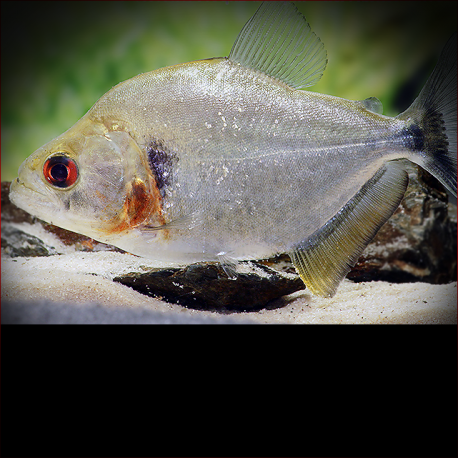More info
Datasheet
| Minimum Tank Size | 420 litres / 110.95 US gallons |
| Maximum Size | 45.0cm / 17.72inches |
| Temperature | 22.2°C / 71.96°F - 27.8°C / 82.04°F |
| Hardness | 1-20ºdH |
| pH | 4.5-7.5 |
General Description
The Serrasalmus Rhombeus, also known as the Black Piranha or Rhom, is part of the Serrasalmidae family, characterized by a compressed body shape, long dorsal fin with 16 or more rays, and sharp serrae on the ventral surface formed by modified abdominal scales. With over 30 described species, identifying the S. Rhombeus can be challenging, especially in its juvenile stage, which lacks the mature deep red eye trait and shares patterning with other species. Various geographical forms of this species exist, differing in size, body form, and coloration, with a notable feature being the deep red eye in mature individuals.
Aquarium Setup
A well-oxygenated aquarium with sandy substrate and driftwood for cover is ideal for S. Rhombeus. While attempts to grow aquatic plants can be made, these fish may nip at them. Maintaining high water quality is crucial, requiring up to 50% weekly water changes. External placement of the heaterstat is recommended to prevent potential biting incidents, and the use of external filters or sturdy heater guards is suggested.
Behaviour
The S. Rhombeus is carnivorous and solitary by nature, making them unsuitable tankmates for other fish species. Attempting to keep multiple S. Rhombeus together is discouraged as conspecifics are likely to engage in aggressive behavior and territorial disputes, leading to potential fatalities until only one remains.
Feeding and Diet
In their natural habitat, S. Rhombeus are opportunistic feeders consuming fish, insects, crustaceans, and even scavenging dead animal remains. In captivity, individuals can be weaned onto dead foods, with juveniles preferring live or frozen bloodworm, Tubifex, Artemia, and chopped prawns. Adults should be fed larger items such as mussels, prawns, and earthworms, with a feeding frequency of two to three times a week. Avoid feeding large amounts of mammalian or avian meat, as it can lead to health issues.
Reproduction & Dimorphism
Breeding S. Rhombeus in captivity is challenging due to their aggressive nature towards conspecifics. Rare instances of successful breeding have been recorded in a well-planted tank environment with careful management of eggs and fry. External sexual dimorphism is not evident, with females typically appearing plumper during spawning conditions.
Habitat and Distribution
Natively found in rivers across Venezuela, Guyana, Brazil, and other South American countries, S. Rhombeus prefer larger, deeper river channels as adults for hunting, while juveniles are commonly found in calm, vegetated areas. Fish coloration varies based on water type, with those from turbid waters being lighter in hue compared to those from clear or black water habitats. Controversy exists regarding the species' distribution, with some suggesting restriction to Guyana despite recorded sightings in various rivers.

